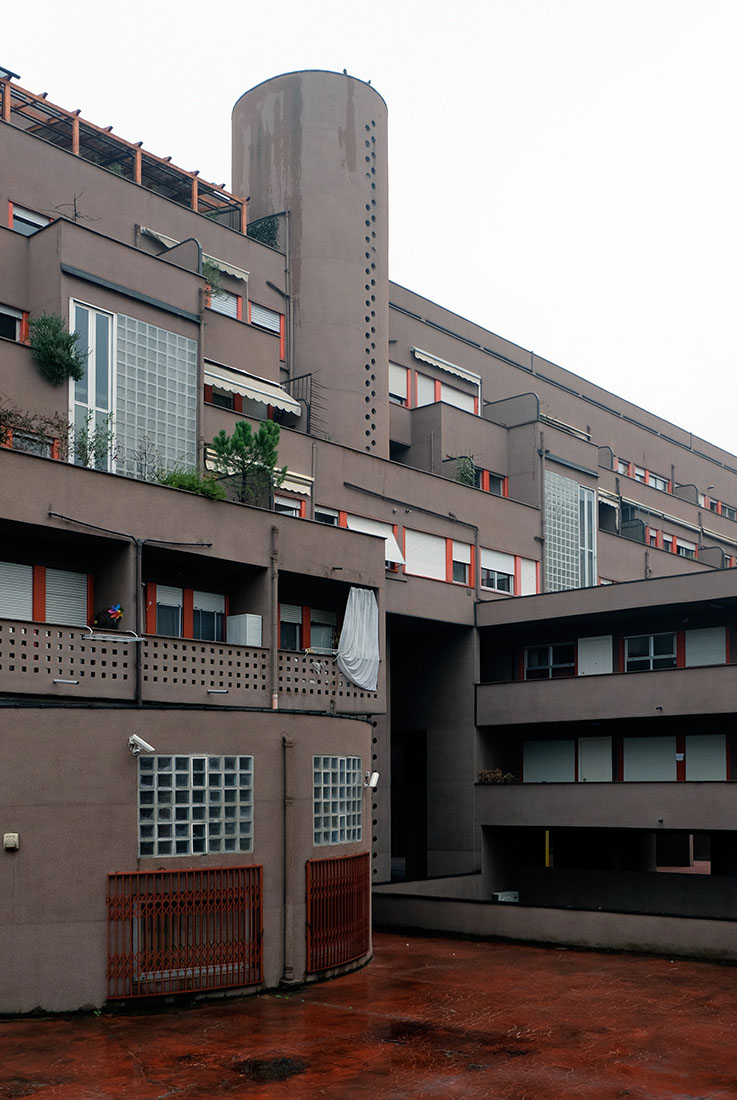 |
 |
 |
 |


Quartiere Gallaratese
Via Cilea 34, Milano
1967 - 1972
The
Monte Amiata Housing Complex in the Gallaratese Quarter in Milan is
considered to be the most famous design by the Italian architect Carlo
Aymonino.
The project saw the collaboration with Maurizio Aymonino, Alessandro de Rossi and Sachim Massaré. Additionally, Aldo Rossi was invited to design one building.
The architects were confronted with the request to build a housing complex for 2400 inhabitants. This anonymous statistic is the result of a conventional standard
established in Milan. The laws permitted to construct 169'000 cubic metres of living accomodation plus the extra percentage allowed for reception, technical services
and garages on the the piece of land 52'700 square metres. According to the low-budget restrictions, an average of 70 cubic metres were allowed per inhabitant.
These calculations indicated the number of people to be housed in the Monte Amiata Housing Complex. There was no specification, how these people were to be
accomodated, but the GESCAL regulations indicated the percentages of large, medium and small apartments. Having in mind these calculations, housing appears
as an anonymous quantity of economical investment, without any relation to its residents.
The design solution was determined right from the start by the advantage of having a single owner of the property. As the apartments were not for sale, but for rental,
the building was planned of a uniform appearance. The design shows an ensemble which is volumetrically defined by diversified elements. With regard to the location of
the complex, the area is complely deprived of either natural or artificial context. The plot is flat, without a topography worth to be mentioned and without relevant natural
charateristics as creek or trees. The adjacent buildings are of an anonymous appearance and consist of 8-storey rectangular blocks or twelve-storey towers. They are
arranged in a repetitive and mundane pattern.
Having in mind these conditions, the attempt was made to accentuate the isolation from its surroundings. A general setup was sought, and the architects tried
to solve the task with a single large construction. The first idea was to create a compact but articulated volume. This idea had to be redeveloped gradually.
This resulted in five building blocks of varied height and depth, which are related to each other by connecting elements, such as ramps, galleries, staircases
and even aerial passages between buildings. The subdivision of the program and the resulting creation of several building blocks resulted primarily from the
different requirements of the regulations. The design clearly breaks with the traditional concept of the private building, by defining itself as an alternative method
for structuring residences and services. From the parking lot on the ground floor, one reaches teh atrium halls. From there is given acces to the galleries and further
on to the internal hallways which serve the duplex apartments.
The project saw the collaboration with Maurizio Aymonino, Alessandro de Rossi and Sachim Massaré. Additionally, Aldo Rossi was invited to design one building.
The architects were confronted with the request to build a housing complex for 2400 inhabitants. This anonymous statistic is the result of a conventional standard
established in Milan. The laws permitted to construct 169'000 cubic metres of living accomodation plus the extra percentage allowed for reception, technical services
and garages on the the piece of land 52'700 square metres. According to the low-budget restrictions, an average of 70 cubic metres were allowed per inhabitant.
These calculations indicated the number of people to be housed in the Monte Amiata Housing Complex. There was no specification, how these people were to be
accomodated, but the GESCAL regulations indicated the percentages of large, medium and small apartments. Having in mind these calculations, housing appears
as an anonymous quantity of economical investment, without any relation to its residents.
The design solution was determined right from the start by the advantage of having a single owner of the property. As the apartments were not for sale, but for rental,
the building was planned of a uniform appearance. The design shows an ensemble which is volumetrically defined by diversified elements. With regard to the location of
the complex, the area is complely deprived of either natural or artificial context. The plot is flat, without a topography worth to be mentioned and without relevant natural
charateristics as creek or trees. The adjacent buildings are of an anonymous appearance and consist of 8-storey rectangular blocks or twelve-storey towers. They are
arranged in a repetitive and mundane pattern.
Having in mind these conditions, the attempt was made to accentuate the isolation from its surroundings. A general setup was sought, and the architects tried
to solve the task with a single large construction. The first idea was to create a compact but articulated volume. This idea had to be redeveloped gradually.
This resulted in five building blocks of varied height and depth, which are related to each other by connecting elements, such as ramps, galleries, staircases
and even aerial passages between buildings. The subdivision of the program and the resulting creation of several building blocks resulted primarily from the
different requirements of the regulations. The design clearly breaks with the traditional concept of the private building, by defining itself as an alternative method
for structuring residences and services. From the parking lot on the ground floor, one reaches teh atrium halls. From there is given acces to the galleries and further
on to the internal hallways which serve the duplex apartments.